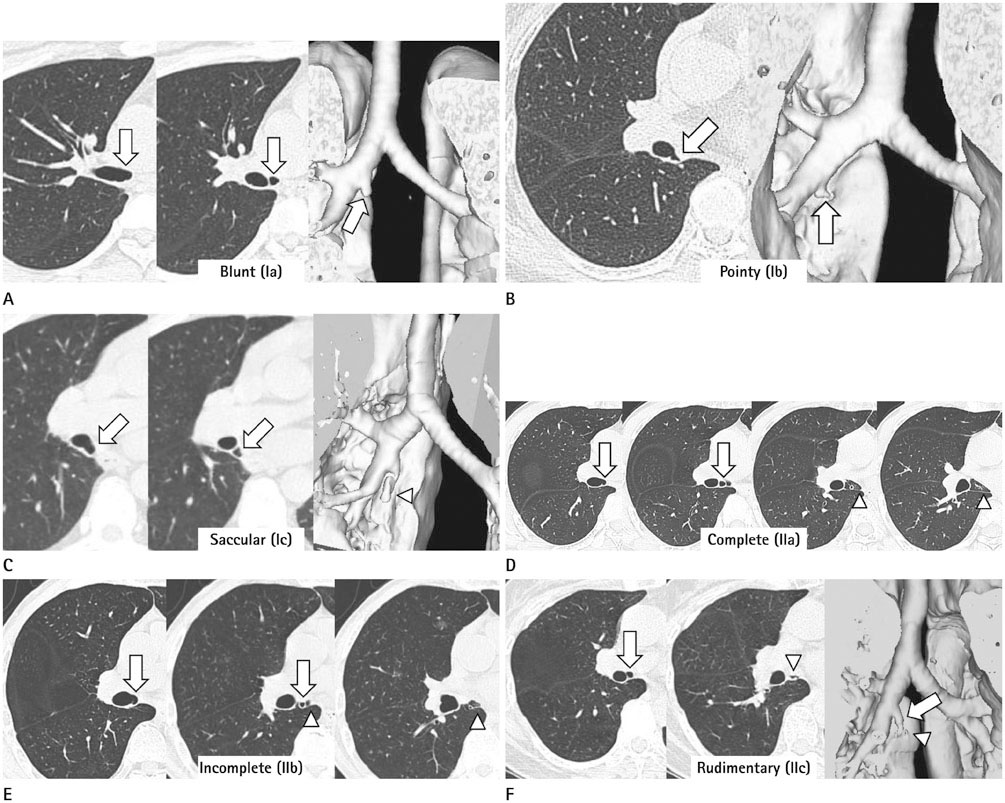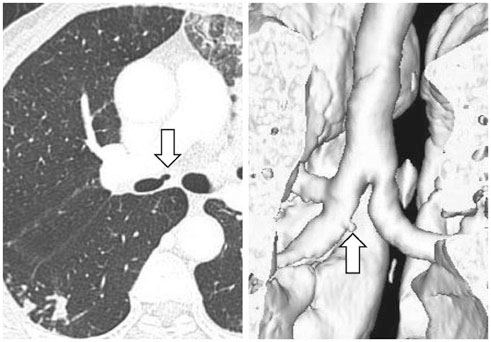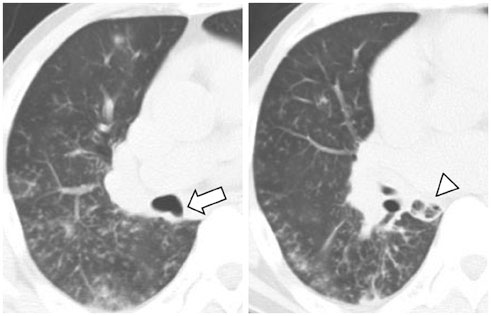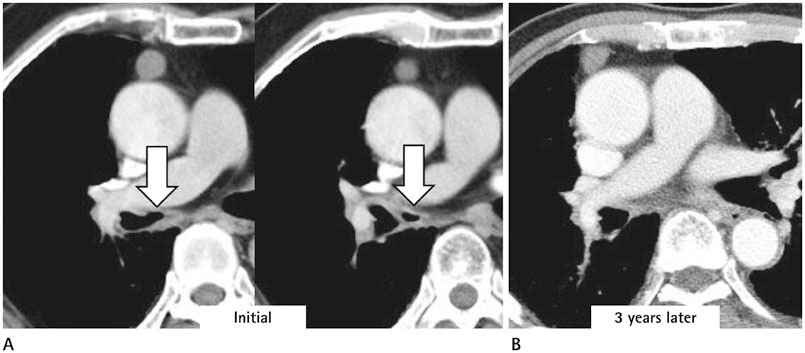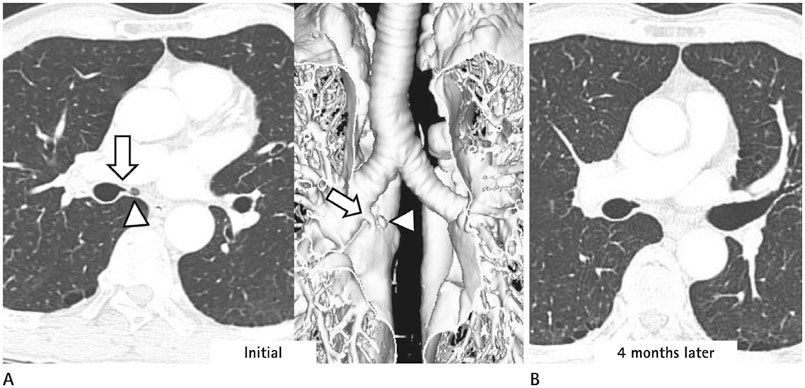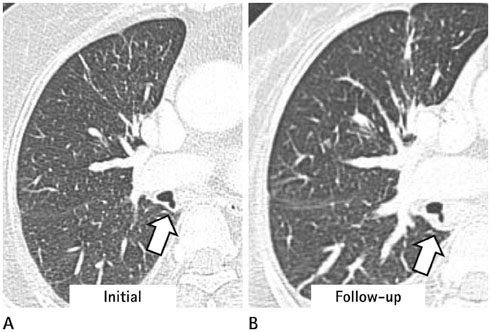J Korean Soc Radiol.
2016 Feb;74(2):82-90. 10.3348/jksr.2016.74.2.82.
Accessory Cardiac Bronchus: Proposed Imaging Classification on Multidetector CT
- Affiliations
-
- 1Department of Radiology, Soonchunhyang University College of Medicine, Cheonan Hospital, Cheonan, Korea. ytokim@schmc.ac.kr
- KMID: 2152599
- DOI: http://doi.org/10.3348/jksr.2016.74.2.82
Abstract
- PURPOSE
To propose the classification of accessory cardiac bronchus (ACB) based on imaging using multidetector computed tomography (MDCT), and evaluate follow-up changes of ACB.
MATERIALS AND METHODS
This study included 58 patients diagnosed as ACB since 9 years, using MDCT. We analyzed the types, division locations and division directions of ACB, and also evaluated changes on follow-up.
RESULTS
We identified two main types of ACB: blind-end (51.7%) and lobule (48.3%). The blind-end ACB was further classified into three subtypes: blunt (70%), pointy (23.3%) and saccular (6.7%). The lobule ACB was also further classified into three subtypes: complete (46.4%), incomplete (28.6%) and rudimentary (25%). Division location to the upper half bronchus intermedius (79.3%) and medial direction (60.3%) were the most common in all patients. The difference in division direction was statistically significant between the blind-end and lobule types (p = 0.019). Peribronchial soft tissue was found in five cases. One calcification case was identified in the lobule type. During follow-up, ACB had disappeared in two cases of the blind-end type and in one case of the rudimentary subtype.
CONCLUSION
The proposed classification of ACB based on imaging, and the follow-up CT, helped us to understand the various imaging features of ACB.
Figure
Reference
-
1. Brock RC. The anatomy of the bronchial tree. London: UK: Oxford University Press;1947.2. Zylak CJ, Eyler WR, Spizarny DL, Stone CH. Developmental lung anomalies in the adult: radiologic-pathologic correlation. Radiographics. 2002; 22 Spec No:S25–S43.3. Chung S, Shim YM. Accessory cardiac bronchus with lung cancer: a case report. Korean J Thorac Cardiovasc Surg. 2010; 43:550–552.4. Miyahara R, Hasegawa S, Yoshimura T, Wada H. A case of squamous cell carcinoma arising from accessory cardiac bronchus. Eur J Cardiothorac Surg. 2002; 22:309.5. Dunnick NR. Image interpretation session: 1999. Accessory cardiac bronchus. Radiographics. 2000; 20:264–225.6. Bentala M, Grijm K, van der Zee JH, Kloek JJ. Cardiac bronchus: a rare cause of hemoptysis. Eur J Cardiothorac Surg. 2002; 22:643–645.7. Ghaye B, Kos X, Dondelinger RF. Accessory cardiac bronchus: 3D CT demonstration in nine cases. Eur Radiol. 1999; 9:45–48.8. Endo S, Saitoh N, Murayama F, Sohara Y, Fuse K. Symptomatic accessory cardiac bronchus. Ann Thorac Surg. 2000; 69:262–264.9. Katayama K, Tsuyuguchi M, Hino N, Okada M, Haku T, Kiyoku H. Adult case of accessory cardiac bronchus presenting with bloody sputum. Jpn J Thorac Cardiovasc Surg. 2005; 53:641–644.10. Sotile SC, Brady MB, Brogdon BG. Accessory cardiac bronchus: demonstration by computed tomography. J Comput Tomogr. 1988; 12:144–146.11. Suzuki M, Matsui O, Takemura A, Kobayashi T, Yoneda K, Shibata Y. Four cases of accessory cardiac bronchus incidentally detected on multi-detector CT. Eur J Radiol Extra. 2006; 57:47–50.12. Ghaye B, Szapiro D, Fanchamps JM, Dondelinger RF. Congenital bronchial abnormalities revisited. Radiographics. 2001; 21:105–119.13. Atwell SW. Major anomalies of the tracheobronchial tree: with a list of the minor anomalies. Dis Chest. 1967; 52:611–615.14. Atwell SW. An aberrant bronchus. Ann Thorac Surg. 1966; 2:438–441.15. Mangiulea VG, Stinghe RV. The accessory cardiac bronchus. Bronchologic aspect and review of the literature. Dis Chest. 1968; 54:433–436.16. McGuinness G, Naidich DP, Garay SM, Davis AL, Boyd AD, Mizrachi HH. Accessory cardiac bronchus: CT features and clinical significance. Radiology. 1993; 189:563–566.17. Shtasel P, Jordan L. The accessory cardiac bronchial stump: case reports. J Am Osteopath Assoc. 1966; 65:486–469.18. Zanetti G, Hochhegger B, Guimarães MD, Marchiori E. Accessory cardiac bronchus causing recurrent pulmonary infection. J Bras Pneumol. 2014; 40:448–449.
- Full Text Links
- Actions
-
Cited
- CITED
-
- Close
- Share
- Similar articles
-
- Accessory Cardiac Bronchus with Lung Cancer: A case report
- CT-Based Essential Cardiac Anatomy for Radiology Residents to Understand Congenital Heart Disease
- True Tracheal Bronchus: Classification and Anatomical Relationship on Multi-Detector Computed Tomography
- Myocardial Contractility, Perfusion, and Viability Analysis Using Multidetector CT in Patients with Ischemic Heart Disease
- Coronary Angiography with Multidetector row Computed Tomography: Part I - Technical Aspects


